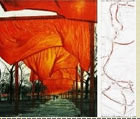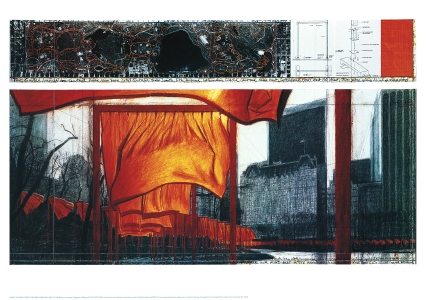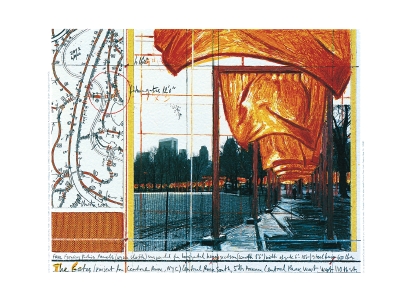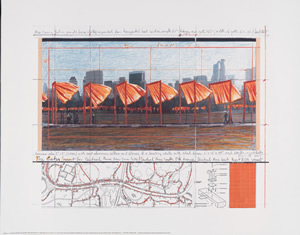Serendip is an independent site partnering with faculty at multiple colleges and universities around the world. Happy exploring!
The Power of Genre
Day 3 of Emerging Genres
"The power of Genre"
![]()
Let's revisit (in light of Rosmarin's theory about
the "power of genre") our own interpretive practices:
Alex: Initially, when i saw the cover of "Modern Genre Theory" there appeared to be many pairs of legs in various shades of orange, red, and yellow. These legs all stop sharply at what I would assume is the waist line of the figures and also seem to be advancing toward the viewer. The most striking feature of the image is the yellow pair in the foreground. This pair has placed it's foot in front of another pair almost as if these sets of legs are in competition with one another. After writing out this seemingly irrational explanation of the image I concluded it would be more rational to assume the pairs of legs are actually arches or doorways. This new conclusion led me to discover what looks like a small window hidden in the center of the arches, almost as if it was in disguise.
What distinguishes a rational from an irrational explanation?
Anna: My initial reaction was that it was doorways. Each doorway took a different perspective on the same background or topic. The doorways brought color to a dismal background. I found this to be metaphorical because the doorways can be the different genres taking an unique perspective on life. Most bring color to life in a large and overbearing way, where others have a lesser effect.After listening to everyone else's description of the picture, I found the most interesting one was that the doorways were not doorways at all, but pants. This completely changed my perspective on what I saw in the picture. Perhaps we were delving too deeply into a metaphor that simply wasn't present. The pants were merely pants.
What makes a metaphor a metaphor?
Vs. "merely" (what??)
how can we explain texts that are different...as if they were the same kind of thing, namely, a sonnet?...by proceeding as if one thing were another...we can do this, because we are "prone to extend classes of things beyond their rational groups"....humans often err willingly and explicitly, for both pleasure and edification. We acordingly "find" faces everywhere; in pansies, in the moon, in knockers on doors, and most frequently, in the "faces" in paintings. And if we look at stars, clouds, and shadows we can find anything we want to find, so great is the intederminacy of such finding places and so willing are we...to accept the most minimal likeness as "like"....
"all thinking is sorting, classifying"...anything can be taken for anything else...we can always choose, correct, invent, or define a class wide enough to make the desired mistake possible...the inevitability of making mistakes is not the bane of criticism but rather, its enabling condition. It makes classification possible, and classification enables criticism to begin.
(For example...)
Rebecca: I saw a series of archways. They reminded me of the Gates exhibit which took place in central park. The exibit was innumerous orange metal archways with an orange fabric hanging down. Both the form and color of the shapes on the cover of the book reminded me of the exhibit. The Gates arches were modeled after Japanesse "Torii" another form of archway which is used to mark the transition from one place to another, which are typically used at the entrance to temples or shrines. I saw the shapes of the cover to represent transition between many different states. I felt that the colors, which were all different, represented transition between very different states. The rough edges also suggested a human hand in these transistions.
Let's look @ Paul Klee's 1937 "Revolution of the Viaducts":
What we see is a viaduct whose arches have broken ranks in such a way that each one of them walks away by itself on flat feet provided by Klee for the purpose. It can be read in several ways - as a symbol of a whole world on the march, as an emblem of individuality and independence, or as an equivocal reference to the concept of revolution. O. K. Werckmeister, in his catalogue essay, suggests that the viaduct in question incorporates elements from Albert Speer's model for the Olympic Stadium in Nuremberg in 1937 and is, in fact, a direct rebuttal of the uniform, obedient, brainwashed society for which that stadium stood. So we can think whatever we please, as Klee would certainly have wished us to do, But then, uniformity of any kind was anathema to Klee, whereas differentiation was life itself.
Cf. (in terms of moving from general to particular and back again)
how we handled the second image:
![]()
Marina: The second image...was more of a clear picture and less interpretation was needed to understand what the images were....This could be a picture representing a specific genre instead of genres as a whole.
Megan: it's somewhat trite to have books representing knowledge which represent growth. Ladder to hand impling that it's an aid to this gain of knowledge? Farmers/other (uneducated) figures toiling (the fields) with a barren tree as their sole companion.
Louisa: the figure instead seems to have climbed a ladder so as to journey up the arm. Perhaps this is meant to convey the idea that what we focus on is the finished product (the text), but that in a more subtle way, we also get a reflection of the author within that (we climb up their arm and explore them, in a way). Wow, I think I gave way too much attention to such a silly picture.
Ellen: The second picture appears, in my mind, to address the result of thechoice between genres....It depicts the deeper idea or theory of the story as a flower and butterfly emerging from the writing, in the midst of an otherwise dry/idea-less landscape. But that's just my interpretation of it.
Rosmarin: As Richard Rorty has observed, "the universal-particular distinction is the only metaphysical distinction we have got" (6-7)...the general-particular debate is literary criticism's most precise staging of this most profound conflict: between the individual reading and its generalization, between practice and theory (6-7).






